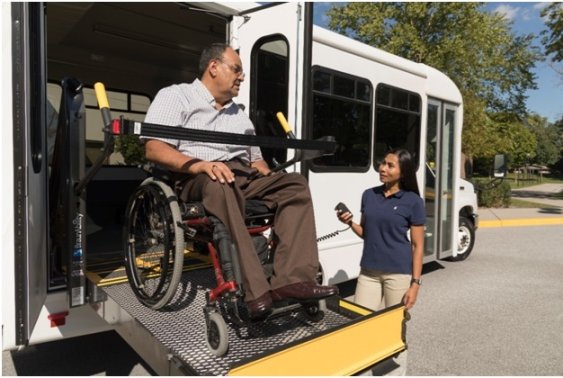Each time a wheelchair passenger, bus driver, school district, or contractor uses the wheelchair lift, there is a danger that the lift may malfunction. While great care is taken by the manufacturer to protect the safety of those who use wheelchair lifts, the lift’s efficiency will eventually decline due to normal wear and tear and the occurrence of unanticipated problems.
Many issues encountered can be handled with preventative maintenance and regular inspections. That being said, parts do go out and equipment fails, it’s simply a normal part of motorized equipment. Lift manufacturers as well as school bus technicians specializing in paratransit lift repair from throughout the country have compiled this list of typical issues and their remedies.

Stop Flaps Located Outside the Vehicle
Incorrect usage of wheelchair lifts is a common cause of breakdowns. Injuries to the stop flaps are one of the main problems reported with paratransit lifts. Although flap damage isn’t immediately a threat to passengers in most cases, they can be damaging to the system if operated in disrepair. Many repairmen choose to replace the damaged outboard stop flap rather than attempt repairs.
Be Positive Wires Are Grounded Correctly
To provide a secure electrical connection between the vehicle and the wheelchair lift, grounding must be performed during installation. Ensuring a good ground keeps the lift operational. Once the lift has been installed, technicians should check to see that it is correctly grounded to guarantee the safety and reliability of the electrical system. It is mandatory that the lift be grounded to the vehicle’s chassis.
Hydropneumatic and Lifting Springs
Wheelchair lifts may break down during usage if the springs fitted in the lift’s arms are neglected. Disrupted lift springs may not directly endanger wheelchair passengers or lift operators, but they may negatively impact the lift’s smooth operation and, in the long term, lead to leveling issues. After some time, the springs usually rust and need to be replaced. Keeping these springs well-lubricated is the best method to keep them functioning for a long time.
Incorrect operation triggers safety mechanisms that immediately stop the motion of the lift.
It’s important to remember that these measures were put in place to keep everyone safe. For public transportation, wheelchair aids would not be practical if they had safety elements like the rollboard barrier. The fix for rollboard barrier issues is to make sure the safety catch hooks aren’t set.
Always check to see whether the power is on before trying to unfold the wheelchair lift. The pump module’s power switch may be found near its base. Make sure the lift’s safety catch hooks aren’t hooked if the electricity is on. In the case of a hydraulic failure, the lift (https://en.wikipedia.org/wiki/Wheelchair_lift) will not abruptly deploy, as there are safety catch hooks. Transporting the lift with these engaged is not recommended.
Each side of the equipment has a safety catch hook built in. Fold the lift all the way inside the vehicle to prevent unauthorized use of the hooks. Make sure you keep your finger on the release button until the hooks have secured the lift. Unfold the lift again when it has been fully folded and stored. If the hand-held pendant fails and the lift won’t stow, you may reset all safety catches by manually stowing the lift.
As the lift is going up or down, it pauses.
Whether you’re raising or lowering the wheelchair equipment, if it suddenly stops, it might be because of pressure from the barriers on either the inside or outside. If the safety sensors for inboard or outboard obstacles are triggered, the lift will not move. When anything presses against these barriers, the sensors know that something is too near to the edge and cannot move until the obstruction is removed.
Solve this problem by relieving any stress on the perimeter walls. The most typical triggers are anything leaning against the barriers, such as bags or wheelchairs. The easiest way to avoid these issues is simply ensuring that the path is clear and there are no items that could trigger the safety mechanisms.
The lift is either too sluggish to fold by itself or requires assistance while doing so.
There are controls on a handheld pendant that allow you to control the machinery movement by unfolding and folding it. It’s possible that after using the machinery regularly for a few months, customers may discover that the button to fold the seat doesn’t function. It may take some time for the machinery to fold, or you may need to assist it in getting started.
To fix this, check that nothing is blocking the inboard or outboard barriers from closing, or readjust the safety valve. If the inner and outer walls feel any pressure, it will not operate, and you’ll need to check for obstructions.
Failed to unfold/lights off on handheld control unit.
When you don’t see any lights operating, and the machinery isn’t operating, the answer is to make sure the electricity is on. Activate the power switch at the base of the pump box before using the equipment. A green light indicates there is power. You may reset all of the safety mechanisms by making sure the lift is completely stowed and using the manual backup pump. There may be an electrical problem if the lights don’t come on when the switch is turned on.
There has been an electrical malfunction in the lift.
Your lift is powered fully by an electrical system, and it may sometimes fail. Click here to read more on electrical faults and grounding. Many modern wheelchair elevators include failsafe devices that cut power in the event of an electrical fault, keeping you safe from being shocked or burned in the process of operating the machinery.
Keep Up With Preventative Maintenance
Wheelchair lift and vehicle manufacturers and technicians agree that regular preventative maintenance is the best defense against costly breakdowns. Pre-trip checks are an essential aspect of maintaining safe and reliable lift operation on a daily basis.

